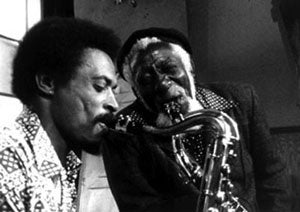Art and business can be a tricky marriage. When an artist makes a business of his craft, one important question is who should be the one who benefits? The artist may argue that the creator should, of course, because that artistry wouldn’t otherwise exist if it weren’t for the person who created it. The business or entity that helped the creator to create, distribute or merchandise their art would obviously expect a percentage of any financial success, but the question always remains, to what degree should that entity benefit—fifty percent? More than half? This debate takes place every day in almost every form of art—movies, television, but especially in music. Larry Clark’s and Ted Lange’s Passing Through explores this age-old argument set in the world of jazz.

The movie’s lead character, Warmack, is a jazz musician in a battle with white record distributors conspiring to keep all the profits from his music to themselves. Like many Black musicians of that time, the white record labels and distribution companies abused the relationships with artists, using the companies’ money, connections and access to control the artists and their talents for their own gain. In Passing Through, these conspirators use violence and intimidation to keep artists like Warmack in his “place”. This imprisonment, both literal at one point in the movie, and mental throughout the rest of the film, sent Warmack on a vigilante mission to overthrow the powers that controlled his music. In Warmack’s eyes, one cannot be free as an artist if he cannot own his music, and he vowed to secure his own freedom by any means necessary. This resolve feels strangely familiar. The artist Prince stopped using his own name and sported a symbol that he said meant “slave” on his face in protest to his record label’s ownership and use of his music. Michael Jackson called Sony executive Tommy Mattola “the devil” and a racist at a public press conference to complain about what Jackson called a conspiracy against Black artists. Whether Prince’s or Michael Jackson’s claims were justified, their arguments were no different than the ones explored in Passing Through.
Even the subplot surrounding Warmack’s girlfriend, Maya, a creative at an ad agency, helped to illustrate this battle between artistry and ownership. Maya’s job was to create ad campaigns, but not without the watchful eye of her white boss and clients who wanted her work to be “less political”, terms which also could be interpreted as “less Black”. As an advertising and public relations executive, Felischa Marye, one of the writers of this blog, often had to tweak creative ideas for Black campaigns in order to suit Caucasian clients. “It caused me to question at what point my creativity as a Black person began and the mass-market business interest ended? It was always hard to say.” Maya certainly couldn’t reconcile the two, which led to her quitting her job at the agency as a result.
Artists of all races are still determined to win against the powers that be. In the past few years, screenwriters have gone on strike to get their fair share of digital distribution, music camps such as Eminem’s that distribute music on platforms like iTunes, launched lawsuits this year to receive billions of dollars in profits from big record labels. It is evident that the debate of artistry versus servitude in Passing Through is alive and continuing to thrive in the entertainment business today. And, because the issue of ownership is such a complicated one, and since artists of all cultural backgrounds seem to be affected, the answer on how to resolve this issue is no longer so black and white.
—Felischa Marye and Michelle Amor






 Mobile Navigation
Mobile Navigation

